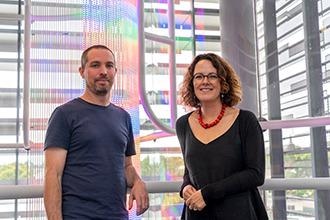In a study that changes the fundamentals of what researchers know about gene silencing, WEHI researchers demonstrated how an “accordion effect” is key to switching off genes.
 Dr Andrew Keniry and Professor Marnie Blewitt. Image Credit: Walter and Eliza Hall Institute of Medical Research.
Dr Andrew Keniry and Professor Marnie Blewitt. Image Credit: Walter and Eliza Hall Institute of Medical Research.
The discovery adds to our knowledge of how humans switch genes on and off in the womb to create the many cell types that make up our body.
It also provides a new approach to using gene silencing in the future to cure or reverse the course of a variety of diseases, including cancer, congenital, and infectious diseases.
The amount of DNA packed into a cell controls gene silencing. A novel accordion-like trigger is vital to the process, according to studies from a group led by Dr Andrew Keniry and Professor Marnie Blewitt.
The findings were reported in the journal Nature Communications.
At a glance
- The tightness or looseness with which DNA is packaged in the cell controls gene silencing
- A vital “accordion effect” is necessary before genes switch off, according to a new study
- The findings add to current knowledge of how various cells develop and show a new trait that will help us harness gene silencing for therapy development in the future
All in the DNA
Human genetic material is made up of DNA that is tightly wrapped around proteins like thread around a spool. Genes can be switched on when it is loosely packed; when it is firmly compacted, genes are switched off.
The researchers discovered that to switch a gene off, the DNA packaging must first loosen up before being tightly compacted.
Professor Marnie Blewitt said the group was taken aback when researchers discovered the accordion-style trigger, which changed their fundamental understanding of this crucial process.
We were amazed to learn that the DNA first needs to relax, to trigger this process. Similar to how an accordion need to open up before it is compressed to elicit a musical note, we found our DNA needs to be opened up first, before it can be compressed and the gene is silenced.”
Marnie Blewitt, Professor, The Walter and Eliza Hall Institute of Medical Research
Silencing power
Gene silencing, according to Dr. Andrew Keniry, has tremendous therapeutic promise.
If we could learn exactly how to switch genes off, we may one day be able to switch off detrimental genes in a variety of diseases. If you could switch off the oncogenes that drive cancer, for example, you potentially could have a new treatment. To be able to realize this dream, we first need to know how the process happens so it can be mimicked with medicines, and our discovery is one more vital piece of this puzzle.”
Dr Andrew Keniry, The Walter and Eliza Hall Institute of Medical Research
The basic mechanistic research was aimed at rapidly identifying novel components involved in the gene silencing process.
To do so, the group devised a “Xmas” system based on red and green tags that are generally switched off during development. The technique used the production of a red and green fluorescent protein to indicate gene activity from each X chromosome to see if the gene silencing procedure was working properly.
The study discovered a novel molecular method of gene silencing, with the researchers identifying the BAF complex as the protein complex essential for this activity.
The research’s next stage will look into why the accordion effect is essential for gene silence and if the technique is relevant to genes on other chromosomes, such as the autosomes.
Source:
Journal reference:
Keniry, A., et al. (2022) BAF complex-mediated chromatin relaxation is required for establishment of X chromosome inactivation. Nature Communications. doi.org/10.1038/s41467-022-29333-1.